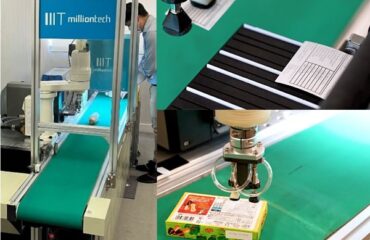The Necessity of Smart Labelling
Hong Kong companies have long relied on manual labour for labelling processes—a system plagued by complexity, errors, and high costs that limits production efficiency and increases management difficulties. In response, more local enterprises are embracing digitalization, and by adopting Million Tech’s robotic labelling system, they are able to immediately reduce manpower, increase labelling speed and accuracy, and lay a solid foundation for long-term competitiveness.
Current Situation and Pain Points
Manual labelling remains common across Hong Kong’s beauty retail (e.g. Sa Sa), logistics, food, and other key sectors. These processes are repetitive and heavily reliant on skilled workers; mistakes and rework are frequent, especially when dealing with multiple SKUs or changing packaging formats. During production peaks, manual speed is often insufficient, and rising labour costs make hiring increasingly difficult for management.
The Value of Robotic Labelling Transformation
Million Tech’s robotic labelling solutions can save up to 70% in manpower, processing 25–30 items per minute and boosting labelling speed three- to four-fold compared to manual methods. For beauty retail giants like Sa Sa, the adoption of intelligent robotic arms enables seamless management of complex, multi-SKU labelling tasks, dramatically reducing errors while making compliance easier and strengthening both brand reputation and consumer confidence.
The government’s Third-party Logistics Service Provider Subsidy Scheme also supports logistics companies as they implement robotic labelling—offering up to HK$1 million in funding so that automation benefits can be realized more quickly.
New Operational Mindset
Robotic labelling is more than an equipment upgrade; it represents management innovation. Employees can transition from repetitive tasks to quality management and process optimization, while decision makers gain real-time oversight of production, quality, and resource allocation through data platforms—accelerating both decisions and response times. The system supports multiple SKUs, languages, and scenarios, enabling enterprises to adapt quickly to market shifts and production demands.
Industry Case Studies: Local Success Stories
- Sa Sa Cosmetics Retail: By implementing Million Tech’s robotic arms for automated labelling, Sa Sa achieved speeds three times faster than manual work, greatly reduced error rates, ensured compliance, and maintained uninterrupted operations even during the pandemic, allowing frontline staff to focus on high-value customer service.
- Third-party Logistics Provider: Leveraging government subsidies, a logistics company uses robotic labelling to complete tens of thousands of labels each day, saving 70% on manpower, achieving consistent quality standards, and redeploying staff to higher-value management and development roles.
- Food Manufacturers/Exporters: Labelling standardization and efficient compliance processes help products access local and international markets, resulting in a marked boost in competitiveness.
Conclusion
Robotic labelling is already widely proven and adopted across Hong Kong’s retail, logistics, and food sectors. For any business willing to embrace transformation, the benefits of cost optimization and upgraded management are immediate, with long-term gains in data-driven, flexible, and sustainable operations. Million Tech’s robotic labelling systems not only help companies save money but also serve as a critical step toward local smart industry and modern service excellence.

Written by: Eric Lai / Head of Robotics
From research and development to the promotion of intelligent labelling systems, I have worked closely with clients across various industries, gaining comprehensive knowledge of product characteristics and technical details. By accurately understanding market demands, I provide businesses with efficient automated labelling solutions.
More insights of Labelling Solution:Robotic Labelling Systems: From Automation to a Data-Driven Management Tool
Success Story References:




